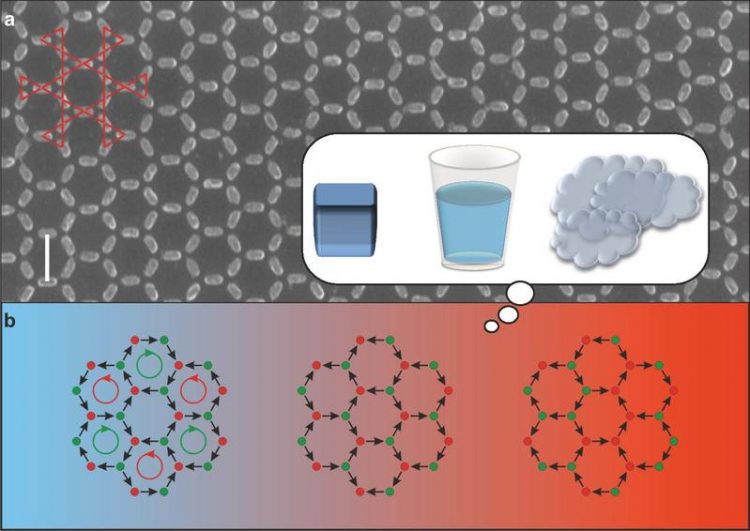Tiny magnets mimic steam, water and ice

PSI researchers have created a synthetic magnetic metamaterial. Depending on the temperature it behaves similarly to ice, water and steam. Paul Scherrer Institut/Luca Anghinolfi
A synthetic material – created from 1 billion nanomagnets – assumes different aggregate states depending on the temperature: the so-called metamaterial exhibits phase transitions, much like those between steam, water and ice. This effect was observed by a team of researchers headed by Laura Heyderman from PSI.
“We were surprised and excited,” explains Heyderman. “Only complex systems are able to display phase transitions.” And as complex systems can provide new kinds of information transfer, the result of the new study also reveals that the PSI researchers’ metamaterial would be a potential candidate here.
The major advantage of the synthetic metamaterial is that it can be customised virtually freely. While the individual atoms in a natural material cannot be rearranged with pinpoint precision on such a grand scale, the researchers say that this is possible with the nanomagnets.
Honeycomb of nanomagnets
The magnets are only 63 nanometres long and shaped roughly like grains of rice. The researchers used a highly advanced technique to place 1 billion of these tiny grains on a flat substrate to form a large-scale honeycomb pattern. The nanomagnets covered a total area of five by five millimetres.
Thanks to a special measuring technique, the scientists initially studied the collective magnetic behaviour of their metamaterial at room temperature. Here there was no order in the magnetic orientation: the magnetic north and south poles pointed randomly in one direction or another.
When the researchers cooled the metamaterial gradually and constantly, however, they reached a point where a higher order appeared: the tiny magnets now noticed each other more than before. As the temperature fell further, there was another change towards an even higher order, in which the magnetic arrangement appeared almost frozen.
The long-range order of water molecules increases in a similar way at the moment when water freezes into ice. “We were fascinated by the fact that our synthetic material displayed this everyday phenomenon of a phase transition,” says Heyderman.
Metamaterial can be customised
In the next step, the researchers might influence these magnetic phase transitions by altering the size, shape and arrangement of the nanomagnets. This enables the creation of new states of matter, which could also give rise to applications: “The beauty of it all: tailored phase transitions could enable metamaterials to be adapted specifically for different needs in future,” explains Heyderman.
Besides its potential use in information transfer, the metamaterial might also prove useful in data storage or for sensors that measure magnetic fields. Very generally it could be used in spintronics, so in a promising future development in electronics for novel computer technology.
The measurements the researchers used to reveal the magnetic orientation of the nanomagnets, and therefore the properties of the metamaterial, can only be conducted exclusively at PSI. The equipment at the SμS, which is unique worldwide, supplies beams from exotic elementary particles called muons, which can be used to study nanomagnetic properties. The project took place in collaboration with a research group headed by Stephen Lee from the University of St Andrews, Scotland.
Text: Paul Scherrer Institut/Laura Hennemann
About PSI
The Paul Scherrer Institute (PSI) develops, builds and operates large, complex research facilities, and makes them available to the national and international research community. The Institute's own principle research interests are matter and material, energy and the environment, and human health. Educating young people is a key priority at PSI, which is why around a quarter of our staff are postdocs, doctoral students or undergraduates. PSI employs a total of 1,900 people, making it the largest research institute in Switzerland. Its annual budget amounts to around CHF 350 million.
Contact
Prof. Dr Laura Heyderman,
Laboratory of Micro- and Nanotechnology, Paul Scherrer Institute; telephone: +41 56 310 2613, e-mail: laura.heyderman@psi.ch
Dr. Hubertus Luetkens,
Laboratory for Muon Spin Spectroscopy, Paul Scherrer Institute; telephone: +41 56 310 4450, e-mail: hubertus.luetkens@psi.ch
Dr. Peter Derlet,
Solid State Theory Group, Paul Scherrer Institute; telephone: +41 56 310 3164, e-mail: peter.derlet@psi.ch
Original publication
Thermodynamic phase transitions in a frustrated magnetic metamaterial
L. Anghinolfi, H. Luetkens, J. Perron, M.G. Flokstra, O. Sendetskyi, A. Suter, T. Prokscha, P.M. Derlet, S.L. Lee, and L.J. Heyderman, Nature Communications, 21 September 2015, doi: 10.1038/ncomms9278 (Link: http://dx.doi.org/10.1038/ncomms9278)
http://Original press release at: http://psi.ch/y424
http://Micro- and Nanotechnology: http://www.psi.ch/media/micro-and-nanotechnology
http://Research Using Muons: http://www.psi.ch/media/research-using-muons
Media Contact
All latest news from the category: Physics and Astronomy
This area deals with the fundamental laws and building blocks of nature and how they interact, the properties and the behavior of matter, and research into space and time and their structures.
innovations-report provides in-depth reports and articles on subjects such as astrophysics, laser technologies, nuclear, quantum, particle and solid-state physics, nanotechnologies, planetary research and findings (Mars, Venus) and developments related to the Hubble Telescope.
Newest articles

Skyrmions move at record speeds
… a step towards the computing of the future. An international research team led by scientists from the CNRS1 has discovered that the magnetic nanobubbles2 known as skyrmions can be…

A flexible and efficient DC power converter for sustainable-energy microgrids
A new DC-DC power converter is superior to previous designs and paves the way for more efficient, reliable and sustainable energy storage and conversion solutions. The Kobe University development can…

Technical Trials for Easing the (Cosmological) Tension
A new study sorts through models attempting to solve one of the major challenges of contemporary cosmic science, the measurement of its expansion. Thanks to the dizzying growth of cosmic…





















